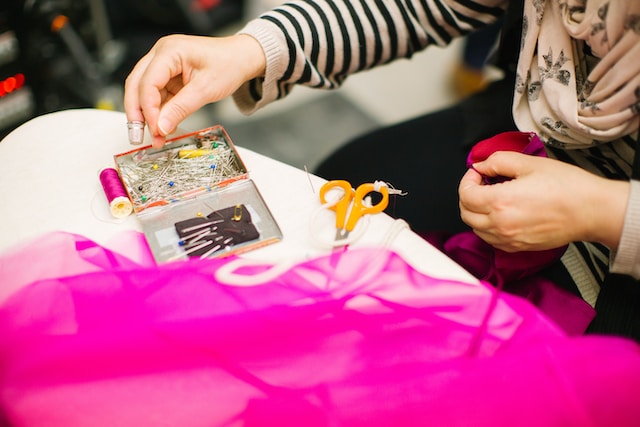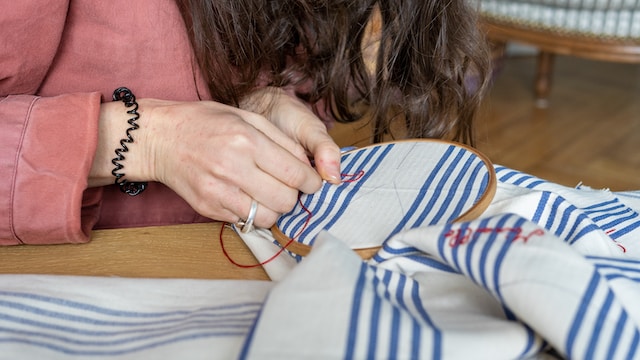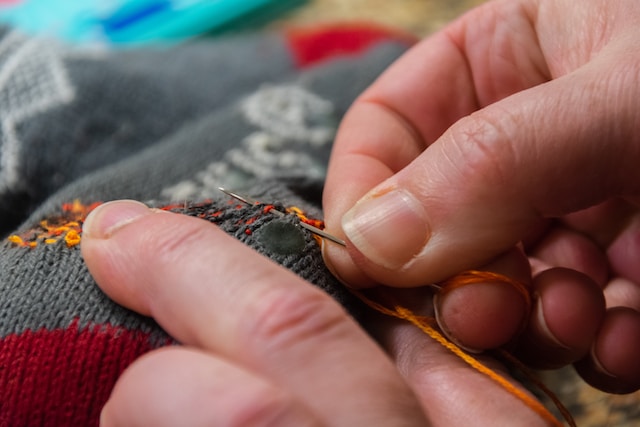Are you a beginner in the world of sewing and want to improve your skills by hand? Whether you’re looking to repair a torn garment or create your own unique designs, sewing is an incredibly rewarding hobby. However, it can be daunting when first starting out.
In this blog post, we’ll provide you with some easy-to-follow Sewing Tips for Beginners by Hand that will help make learning how to sew by hand a breeze. From selecting the right materials to mastering basic techniques, our guide is designed for beginners who want to take their creativity up a notch. So grab your needle and thread – let’s get started!
What You’ll Need To Get Started?
-A needle
-A spool of thread
-Scissors
-A thimble (optional)
-Fabric
-Marking tools (chalk, pins, etc.)
Assuming you have no prior experience with sewing, these are the supplies you will need to get started. First, you will need a needle and a spool of thread. You will also need scissors to cut the fabric. A thimble is optional, but it can be helpful to prevent accidental needle pricks. Finally, you will need fabric and marking tools. Chalk or pins can be used to mark the fabric before you begin sewing.
The Basics of Sewing By Hand

Assuming you already know how to thread a needle and knot the thread, there are really only a few basic stitches you need to know in order to sew by hand: the straight stitch, the running stitch, and the backstitch. With just these three stitches, you can sew almost anything by hand.
The straight stitch is the most basic of all sewing stitches and is used for seams, hems, and gathering fabric. To make a straight stitch, simply push the needle up through the fabric at the desired starting point and pull it back through to the underside of the fabric. Then, holding onto the tail of the thread with your non-sewing hand, insert the needle back up through the fabric at a consistent distance from where you first inserted it. Continue this pattern until you reach the end of your seam or desired stitching area.
The running stitch is similar to the straight stitch but instead of making each stitch even with each other, you want to make each new stitch just slightly shorter than the last one. This creates a “running” effect and is often used for decorative purposes or when gathering fabric. It can also be used as a basting stitch to temporarily hold two pieces of fabric together before sewing them permanently with a straight or zigzag stitch.
To make a running stitch, simply follow the same steps as for making a straight stitch but make each new stitch slightly shorter than the last one.
How To Fix Common Mistakes?

If you’re just starting out with hand sewing, there are a few common mistakes that you might make. But don’t worry, they’re easy to fix!
One mistake is sewing with the needle pointing in the wrong direction. This will make your stitches look messy and uneven. To fix this, simply turn the fabric around so that the needle is pointing in the right direction.
Another mistake is not holding the thread tight enough. This can cause your stitches to be loose and come undone easily. To fix this, hold the thread taut as you sew, and be sure to pull it tight after each stitch.
A third mistake is not using a thimble. This can make sewing difficult and uncomfortable, as well as causing needle pricks. To avoid this, simply put a thimble on your finger before sewing.
Finally, a fourth mistake is sewing too fast. This can again result in messy and uneven stitches. Take your time when hand sewing, and focus on making each stitch perfect.
Advanced Sewing Tips for Beginners by Hand

There are a few advanced hand-sewing techniques that can come in handy when you’re looking to take your sewing to the next level. One such technique is the blind hem stitch, which is used to hem a garment so that the stitches are not visible from the outside. This can be tricky to master, but once you get the hang of it, it’s a great way to give your garments a professional finish.
Another advanced hand-sewing technique is the French seam. This is a seam finish that is often used in high-end garments, as it gives a clean and polished look. It can be time-consuming, but it’s worth it for that perfect finish.
If you’re looking to add some embellishments to your garments, there are a few different hand-embroidery stitches that you can use. These include basic stitches like the running stitch and chain stitch, as well as more complex techniques like buttonhole stitch and satin stitch. With a little practice, you’ll be able to sew any design you can imagine!
Projects for Beginners
If you’re a beginner sewer, start with some simple projects that will help you get comfortable with the basics of sewing by hand. Try sewing a straight line, a curved line, and a few basic stitches like the running stitch, backstitch, and whipstitch. Once you’ve mastered those, you can move on to more complex projects like sewing a seam, making a buttonhole or hemming a garment.

Where to Find More Help and Resources?
Whether you’re just getting started with hand sewing or you’ve been sewing for a while, it’s always helpful to have a few resources on hand. Here are a few of our favorite places to find more help and resources for hand sewing:
The Sewing Machine Company:
The Sewing Machine Company offers a wide variety of sewing machines, fabrics, and other supplies, as well as helpful classes and tutorials.
Sewtopia:
Sewtopia is an online community of sewers, offering helpful articles, tutorials, and forums where you can ask questions and get advice from other sewers.
Sew4Home:
Sew4Home is a website devoted to helping people learn to sew, with articles, tutorials, patterns, and more.
These are just a few of the many great resources available for hand sewers. With a little bit of exploration, you’re sure to find the perfect resource for your needs.

Tips and Tricks for Hand Sewing
Assuming you are a complete beginner to sewing by hand, here are some tips and tricks to get you started:
1. Start with a simple project. A small, rectangular pillow cover is a good place to start. Cut two pieces of fabric in the desired size, plus an extra inch or two for seam allowance.
2. Choose a needle and thread that are appropriate for your fabric. A sharp needle and strong thread are essential for success.
3. Thread your needle, leaving a long tail that can be easily tied off later. Start by making a small knot at the end of the thread.
4. With the wrong sides of the fabric facing each other, begin stitching the two pieces together using a basic running stitch. Remember to keep your stitches even and consistent in size.
5. When you reach the end of your seam, make another small knot to secure the threads before cutting them off.
With these tips in mind, sewing by hand can be easy and enjoyable!
Conclusion
Sewing by hand can be a very satisfying creative process, and with the right knowledge and tools, it doesn’t have to be overwhelming. We hope that this article has provided some helpful tips for getting started on your sewing journey. As you become more experienced, you will be able to take on bigger and better projects. So don’t hesitate – get out there and start creating something beautiful!

[…] are pros and cons to both sewing by hand and by machine. If you’re a beginner, sewing by machine may be the better option for you. Sewing by machine is faster and can be less […]
[…] For further learning, consider exploring hidden stitch techniques for seamless finishes or sewing tips for beginners by hand, which can complement your machine sewing skills and offer insights into hand-finishing […]